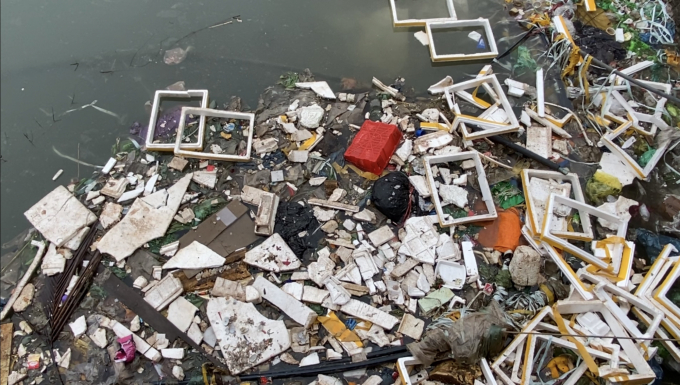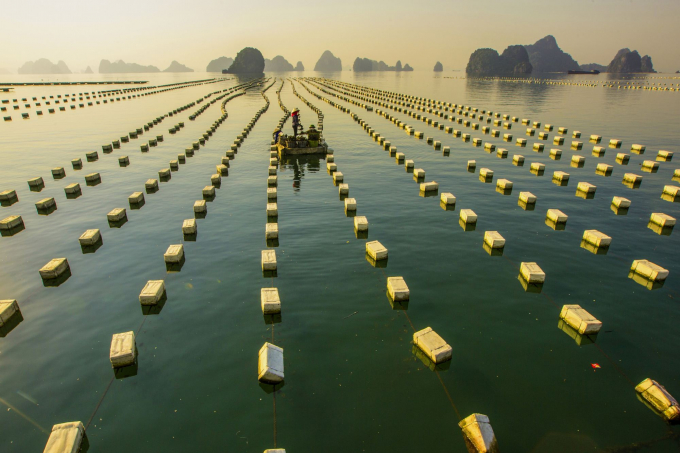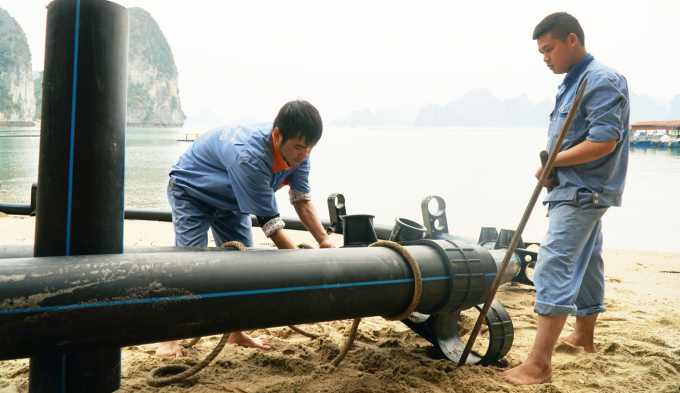November 26, 2025 | 17:26 GMT +7
November 26, 2025 | 17:26 GMT +7
Hotline: 0913.378.918
November 26, 2025 | 17:26 GMT +7
Hotline: 0913.378.918

Plastic waste, mostly foam buoys are seen in coastal area in Van Don District, Quang Ninh Province. Photo Anh Thang.
Nguyen Van Phu, of Ha Long Commune, Van Don District in the coastal province of Quang Ninh has raised aquaculture for nearly 30 years.
He said that since 2008, more and more local people have been raising aquaculture at floating farms. With styrofoam buoys widely used at the farms, they spend less but earn much more than conventional farming.
However, according to a survey on plastic waste in Ha Long bay conducted in 2018, styrofoam buoys is among the five most popular plastic waste detected. Notably, styrofoam buoys accounted for 70 per cent of the detected plastic waste there.
Currently, Quang Ninh Province has nearly 20.000 aquaculture raising cages, mostly in Cam Pha, Van Don, Dam Ha, Hai Ha and Mong Cai.
Most of the fishing cages are made of wood, foam buoys due to the materials are much available, cheap and easy for people to manage.

Thousands of foam buoys are used at aquaculture farms in Ha Long Bay. Photo: Anh Thang.
Nguyen Van Cong, director of the province’s Agriculture and Rural Development Department said that local authorities recognised the negative impacts of styrofoam buoys on the marine environment.
The agriculture department studied and proposed standards for materials used to make floating buoys in fishing farms.
The standards were expected to help local authorities better control environmental issues relating to coastal aquaculture farms.
In 2015, the department developed projects on using new materials to increase productivity, production and ensure environmental protection at aquaculture farms, Cong said.
Notably, the department implemented a project on using High-Density Polyethelene (HDPE) to make aquaculture-raising cages. As many as 30 households joined the pilot programme with a total area of about 6,000 sq.m.
“Until 201, the HDPE project generated positive results as the HDPE cages effectively dealt with farming conditions in Quang Ninh including temperature, salinity and sea weather and most importantly, the HDPE cause no harm to the environment,” he said.
In May 2021, Quang Ninh province People’s Committee issued Decision No30/2021/QD-UBND on amending and add technical standards for floating materials used in aquaculture farming.
The move reflected the vision and responsibility of local authorities in ensuring marine economic growth go in line with environmental protection.

HDPE is used to make fish cages. Photo: Anh Thang.
Accordingly, from the beginning of next year, aquaculture farms in the province must shift to use materials that meet the standards.
Until now, two enterprises based in the province registered to use HDPE.
Super Truong Phat Plastic Joint Stocks Company developed aquaculture-raising models with items made from HDPE, for example, cages, buoys and floors to raise oyster, fish and seaweed.
Nguyen Thi Hai Binh, the company director said that the HDPE could be used for up to 30-50 years. It is safe to water resource, stainless.
As Quang Ninh was usually hit by 6-7 storms yearly, aquaculture growers faced risks to their safety and property, she said, adding that it was reasonable to use HDPE.
“ As an HDPE supplier, Super Truong Phat Company offers assistance to aquaculture farms in shifting to use the new materials as well as permanent warranty,” she said.
However, after recent inspections, the Department of Agriculture and Rural Development found that people still use foam buoys and some ball/rectangle-shaped buoys that are sold on the market without meeting legal requirements.

(VAN) After the institutional merger, Da Nang possesses significant forest-carbon reserves and is proactively engaging in the carbon market, creating a new revenue stream.

(VAN) An Giang strengthens communication against IUU fishing, increases inspections and sanctions, and is determined to remove the EC’s “yellow card” while developing a sustainable fisheries sector.

(VAN) As green transition becomes a global trajectory, Viet Nam’s biggest challenge is not only technology and models, but how to ensure that capital flows reach the right beneficiaries.

(VAN) The Ministry of Agriculture and Environment must spearhead the construction of green governance, spanning decision-making processes and investment standards to policy evaluation mechanisms.

(VAN) The Agriculture and Environment sector of Khanh Hoa has achieved numerous milestones over the past 80 years, contributing significantly to the goal of establishing the province as a centrally governed city by 2030.

(VAN) Viet Nam is entering the pivotal period of 2025-2030, moving toward the formulation of the Remote Sensing Law, which will establish a legal foundation for the development of national digital data.

(VAN) The agricultural sector is finalizing the strategic framework for emission reduction, setting the goal of sharply cutting methane and 403.7 million tons of CO2 equivalent and moving toward Net Zero by 2050.